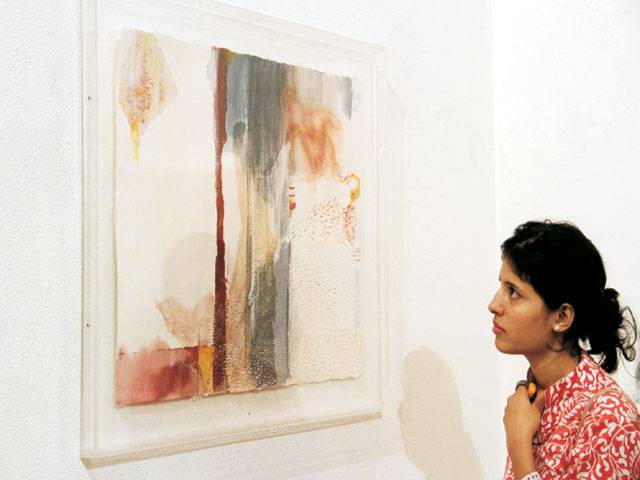Islamabad - A group exhibition opened here yesterday at Satrang Gallery by 10 renowned and celebrated artists, as most of them are recognised as pioneers of the contemporary art movement in Pakistan.
The exhibition titled “Private Mythologies” displayed the artworks of eminent artists of the country including Salima Hashmi, Naazish Ataullah, Afshar Malik, Anwar Saeed, Quddus Mirza, Mansoora Hassan, Noorjehan Bilgrami, Shireen Kamran, Mehr Afroz and Nahid Raza.
The show was curated by the art critic Aasim Akhtar, whereas, renowned artist, critic, curator and professor Salima Hashmi, while contributing her own work in the show, inaugurated the exhibition. Satrang Gallery in its fourth year takes great pride in hosting some of Pakistan’s most respected artists, as this show is curated by the art critic Aasim Akhtar, showcasing the works of celebrated artists and many of whom have been the pioneers of the contemporary art movement in the country.
In the past years Satrang Gallery has been home to more than 300 artists, from young, new graduates to senior, established artists, the Gallery has hosted more than 40 exhibitions in itsspace, as well as organized competitions, charity exhibitions and book launches in the adjacent Satrang corridor, director of Satrang Gallery, Asma Khan stated.
“I have tried to internalise the urgency to generate a situation receptive to complex spaces combining the big and the small, the old and the new, acceleration and deceleration, noise and silence”, said Aasim Akhtar, the curator of the gallery.
Analysing the Salima Hashmi work, Asma Khan said, “Essential to Hashmi’s expression is the highly charged psychoanalytical subtext that holds in balance her emotional and ideological imperatives as well as her sense of the `inner’ and `outer’ worlds.”
Describing Anwar Saeed’s work, Asma said, “though radical political and social statement has not always been a conspicuous determinant in his work, it has dealt in ingenious ways with several aspects of socio-political stratification.”
Commenting on Shireen Kamran’s work, Asma said, “Ranging from spare to sprawling, the process of drawing occupies a central place in Kamran’s production, both as a formal and informal, through ideas, recording many of her earliest forays at charting emotional space through an abstract language.”
Curator of the gallery said, Raza has once again explored her feelings about the female sensibility. Her paintings aim to expand the viewer’s soul by offering beauty of form, texture, and colour.
Coming on Mansoora Hassan artwork, Asma said, “she is best known for the impulsive surfaces created in her early `stroke’ paintings.
An exploration of the continuity, surface, and texture of the single, repeated gesture, directly linked to the body, `stroke’ is a term with strongly haptic associations. Hassan draws upon a vast repertoire of painterly techniques - smearing, blending, bleeding - to convey a strong material presence.”
Talking about Noorjehan Bilgrami, she said, as an articulation of fugitive states, Noorjehan’s `fields’ are perhaps best illuminated by French philosopher Gaston Bachelard, who wrote: “Each one of us should make a surveyor’s map of his lost fields and means. Thus we cover the universe with drawings we have lived.”
Mehr Afroz’s work embraces the daily litany of responsiveness, keenly mapping nature and its cadences as a metaphor for the cyclical nature of human relationships. She narrates lived experience without the directed specificity of autobiography or storytelling.
Afshar Malik works in a distinct tradition which evolved to cope with what happens when you abandon literary narrative and text as a subject matter.
Whereas the artist, Quddus Mirza is far too intrigued by the relationships between people and things and how those relationships might somehow be represented on a flat picture plane to be seduced into the metaphysical infinities of the sublime. For him abstraction is still an experiment, involving a careful deconstruction in a search for the internal structure that gives an image its emotional resonance, Asma maintained.
“Naazish Ataullah’s work examines the relations among self-consciousness, subjectivity, and age. She offers a configurative approach, investigating conceptual clusters, the metaphor of the body surface as limit or wall, the phantasm of flaying, the utopian fantasy of transcending the skin, the epidermis as a legible screen,
and the body and its parts as bearers of ethnic information, colour traces, or stigmata”, the curator of the gallery further explained.
The exhibition will continue till November 6.
Saturday, April 20, 2024
Pioneers’ artwork displayed at Satrang

22 suspects arrested
April 20, 2024
RCCI chief for promoting law-abiding culture
April 20, 2024
Provision of quality education govt’s priority: KP minister
April 20, 2024
A Tense Neighbourhood
April 19, 2024
Dubai Underwater
April 19, 2024
X Debate Continues
April 19, 2024
Hepatitis Challenge
April 18, 2024
IMF Predictions
April 18, 2024
Kite tragedy
April 19, 2024
Discipline dilemma
April 19, 2024
Urgent plea
April 19, 2024
Justice denied
April 18, 2024
AI dilemmas unveiled
April 18, 2024
ePaper - Nawaiwaqt
Advertisement
Nawaiwaqt Group | Copyright © 2024





